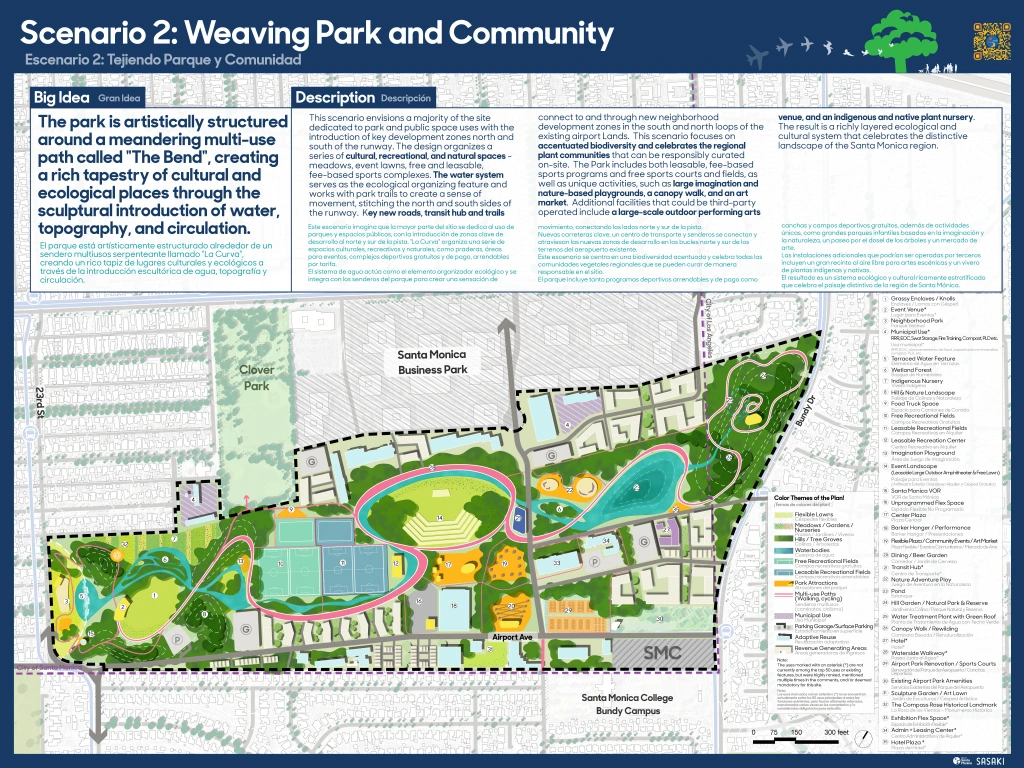This article first appears at the Healthy City Local.
In case you have lost the thread of these posts, let me reiterate that there are three factors that will affect the planning and construction of the park that will replace Santa Monica Airport: land, money, and time. In the previous two posts I’ve discussed the first two, now it is time’s turn.
For building the park, there needs to be both a short-term calendar and a long-term calendar. That is another way of saying that there can be an ultimate goal, but there also needs to be a way to get to it. You know: a journey of a thousand miles starts with a small step.
The planning process so far has focused on a long-term calendar. (I say “so far,” because as I said in a prior post, I have heard from Sasaki and from city staff that they will be presenting a phasing schedule to City Council.) The planners have asked the public for wish lists of what they would want to see in a park. Specific limitations, such as cost figures or budgets, haven’t been placed on these wishes, although in general terms survey participants have been asked to “balance” costs and revenues.
From these wishes the planners, Sasaki and staff, have developed three scenarios. These scenarios present final, if hypothetical, visions of what the park would look like. Because City Council instructed the planners to make the park revenue neutral, the scenarios, particularly the more ambitious two of the three, include a lot of undefined “revenue generating” uses.

These revenue-generating uses distort the planning process, because, as I’ve discussed previously, they are hardly certain. Not only do we not know how much money they would generate, but also nearly all of them, and all of those that might produce the most revenue, would require a public vote to amend Measure LC. This would require extensive planning processes for these uses before they could go to a vote. We think we are planning a park, but in fact we are planning a hypothesis.
Nonetheless, it is from the wish lists embodied in the scenarios that City Council will, at its meeting July 8, choose the elements to include in the “project” for purposes of environmental review. The plan is that with further public outreach this fall, Sasaki and staff will develop a project that the council will approve in December for the EIR, along with alternatives as required by the California Environmental Quality Act (CEQA).
This is where the timeframe becomes a factor. The council will face the question whether the environmental review should focus on a long-term aspirational project, or a more pragmatic shorter term project.
There are several reasons to focus on the shorter term.
Primarily we need a shorter-term project because the public needs to have faith that when the airport closes there will be a genuine path towards the park. Specifically, in Santa Monica, many extensive public processes have resulted in nothing. More generally, people have lost considerable faith in the ability of government to get good things done.
A side but not insignificant benefit on making the project more short-term is that the less that needs to be considered in the EIR, the less it will cost. If we study highly aspirational features now, or undefined uses that require a public vote to be approved, we may be spending money to study features that will never be built, or might be built long in the future. There is no legal difficulty amending the EIR in the future, or doing a specific EIR, to add a feature once it is planned and/or as funding for it might become available.
What might the short-term calendar for park development look like? As I wrote in my posts on land and money, first we should look at the easiest land to convert into a park, namely the runway, and at the money that will be available from local sources, such as airport leasing revenues, park user fees, and, possibly, water and other environmental funds. Some revenue sources, such as a café, can be included because they are consistent with parks and can be consistent with Measure LC if zoning is amended.
Then we should be thrifty, and plan a “starter park” that we can build with available funds.
There is a lot that can be done “on the cheap.”
San Francisco this spring created and opened a 50-acre park by closing a highway that ran up the western edge of the city, along the Pacific. Closing the highway was controversial, but was approved by almost 55% of voters. Notably, San Francisco opened the park before starting its long-term planning process; the city’s parks department, working with a budget of about $1 million, and helped by volunteers, built basic amenities. According to the New York Times (this article might be behind a paywall), in the first month more than 150,000 people visited the park.
Directly relevant to converting our airport into a park, the National Park Service converted Crissy Field, a former military airport, in San Francisco into an approximately 100-acre urban park in the 1990s. The cost then was about $40 million, more than half of which came from philanthropic sources. The City of Chicago converted its local airport, Meigs Field, into Northerly Island Park, also for a reasonable price.
There is a role for big plans, but let’s not allow long-term perfection to stymie shorter-term good. A park with portable toilets before the plumbing goes in is better than no park.
Thanks for reading.
